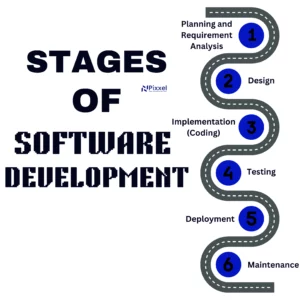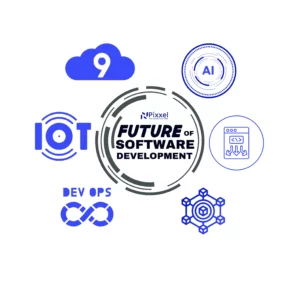Software development is the process that creates computer programs and applications. It includes building, designing, launching, and maintaining software that makes everyday life and work easier.
Software is everywhere—from the apps on our phones to the programs businesses use to manage their work.
In this blog post, we will look at the different parts of software development as an experienced software agency. We’ll explain how it works, the phases involved, the methods and tools used, and the challenges it brings.
Finally, we’ll take a look at the future of software development.
Key Points
- Software development is a full process: It includes planning, designing, building, testing, launching, and maintaining software used in everyday life and work.
- Different roles and methods: Various roles like project managers, developers, and testers work together to build successful software. Methods like Waterfall, Agile, and DevOps guide the development process.
- Tools and technologies: Software development relies on special tools like Integrated Development Environments (IDEs), version control systems, and cloud computing platforms to ensure efficiency and quality.
- Facing challenges: Developers need to handle complex projects, tight deadlines, changing requirements, and security concerns while keeping up with technology advancements.
- The future of software development: Trends like artificial intelligence, low-code/no-code platforms, DevOps, and cloud-native development are shaping the future, while the Internet of Things and blockchain technologies bring new opportunities.
Understanding Software Development: An Overview
Software development is the process of designing, building, launching, and maintaining software. It involves many activities, from writing code to ensuring that the software meets quality standards. The Software Development Life Cycle (SDLC) covers all these steps. This structured approach ensures the final product is functional and reliable.
Phases of Software Development
The SDLC typically has several key phases:
- Planning and Requirement Analysis
- Design
- Implementation (or Coding)
- Testing
- Deployment
- Maintenance
1. Planning and Requirement Analysis
Every successful software project starts with careful planning. In this phase, developers meet with clients or stakeholders to find out what the software should do. It’s important to clearly define the requirements and make sure everyone agrees on the goals. This analysis helps identify the software’s functions and goals and spot potential problems early.
2. Design
Design is the phase where the technical details of the software are worked out. Developers design the architecture, user interface layout, and database structure. Technologies needed for the project are also chosen during this stage. A well-thought-out design ensures the software is stable, secure, and scalable.
3. Implementation (or Coding)
Implementation, often called coding, is when developers write the actual software. This is the most technical part of software development and requires expertise in programming languages and technologies. The code must be well-structured and efficient to make future debugging and expansion easier.
4. Testing
Testing is a crucial phase in software development because it ensures that the software works as expected and has no major bugs. There are different types of testing, including functional testing, system testing, and user testing. This phase helps identify issues before the software is released to users.
5. Deployment
In the deployment phase, the software is made available to the public or end-users. This can happen through publishing an app in an app store or installing software on company servers. Deployment requires careful planning to ensure the transition is smooth and the software is ready to use.
6. Maintenance
Software development doesn’t end with deployment. After release, developers need to provide regular updates to add new features, fix bugs, or patch security vulnerabilities. Maintenance is a continuous process that ensures the software remains useful throughout its life.
Note: If you’re looking for custom software solutions in Vienna, we are the right partner for you. Let’s discuss your project and make it a success. Contact us today!
Roles in Software Development
There are many different roles in software development, and they all work together to create a successful product. Each role has specific responsibilities and brings different skills to the table:
| Role | Summary |
|---|---|
| Project Manager | Oversees the project and ensures the schedule, budget, and deadlines are met. |
| Business Analyst | Works with stakeholders to meet business requirements. |
| Software Architect | Makes decisions about software structure, technology, and architecture. |
| Developer | Writes and maintains the code (Frontend, Backend, Full-Stack). |
| QA Tester | Tests the software for bugs and ensures quality standards. |
| UI/UX Designer | Designs the user experience and interface for usability and design. |
| DevOps Engineer | Manages software deployment and optimizes performance. |
Methods in Software Development
Different methods are used in software development to structure and streamline the process. Each method has its own benefits and is chosen depending on the project’s needs:
Waterfall
The Waterfall method is one of the oldest and most traditional approaches to software development. It follows a linear and sequential process, where each phase must be completed before the next begins. Waterfall is easy to understand and manage, making it suitable for projects with clearly defined requirements. However, it is a rigid method that can be challenging for projects where requirements may change.
Agile
Agile software development is a relatively flexible and iterative approach. It emphasizes collaboration, customer feedback, and quick delivery of small updates. Methods like Scrum and Kanban break the project into smaller parts called sprints or iterations, each lasting a few weeks. Agile allows continuous improvement and adaptation, making it ideal for projects with changing requirements and frequent updates.
DevOps
DevOps combines software development (Dev) and IT operations (Ops) to streamline the development and deployment process. It emphasizes automation, continuous integration, and continuous delivery (CI/CD) to ensure software is released quickly and reliably. DevOps promotes a culture of collaboration between development and operations teams, which shortens the time to market and improves the quality and performance of the software.
Rapid Application Development (RAD)
This method prioritizes rapid prototyping and feedback over long planning and development cycles. Rapid Application Development focuses on an adaptive approach to software development and aims to develop software quickly and iteratively with ongoing user feedback. This method is well-suited for projects where requirements are likely to change, and speed is critical.
Tools and Technologies in Software Development
Software development relies on various tools and technologies that support the different phases of the SDLC. Here are some essential tools and technologies used in modern software development:
Integrated Development Environments (IDEs)
IDEs are software applications that provide comprehensive facilities for software development. IDEs typically consist of a code editor, debugger, and build automation tools, making it easier for developers to write, test, and debug code. Popular IDEs include Visual Studio, IntelliJ IDEA, and Eclipse.
Version Control Systems
Version control systems (VCS) are essential for managing code changes and enabling collaboration among developers. They track modifications to the code and allow developers to work on different parts of the project simultaneously while merging changes seamlessly. Git is the most widely used VCS, and it integrates with platforms like GitHub and GitLab, which offer additional collaboration features.
Continuous Integration/Continuous Delivery (CI/CD) Tools
CI/CD tools automate the process of code integration, testing, and software deployment. They ensure code changes are delivered to users quickly and reliably, reducing the risk of errors and improving the overall quality of the software. Popular CI/CD tools include Jenkins, CircleCI, and Travis CI.
Project Management Tools
These tools help teams plan, track, and manage their work efficiently. Project management tools ensure that projects stay on schedule and within budget. Typically, these tools include features like task management, time tracking, and collaboration. Popular project management tools include Jira, Trello, and Asana.
Testing Tools
Testing tools are crucial because they automate the process of testing software and help identify and fix bugs more efficiently. These tools can run various types of tests, including unit, integration, and performance tests. Popular testing tools include Selenium, JUnit, and TestNG.
Cloud Computing Platforms
Cloud computing platforms provide scalable infrastructures and services necessary for deploying software. These platforms offer resources like virtual machines, storage, and databases, enabling developers to build and deploy applications without managing physical hardware. Major cloud computing platforms include Amazon Web Services (AWS), Microsoft Azure, and Google Cloud Platform (GCP).
Challenges in Software Development
Despite advancements in methods and tools, software development still presents challenges. Here are some of the common obstacles developers face:
Managing Complexity
Software systems are becoming more complex, making it difficult for developers to manage. Developers must navigate complex architectures and integrate numerous components while ensuring the system remains maintainable and scalable.
Meeting Deadlines
Software development projects often have tight deadlines, requiring careful planning and efficient execution to deliver on time. It can be challenging for developers to balance speed and quality, especially when unexpected issues arise.
Ensuring Quality
Ensuring that software is free from bugs and functions as expected can be challenging. Rigorous testing and quality assurance processes are necessary, but they can be time-consuming and resource-intensive.
Adapting to Changing Requirements
Many projects require changes over time as stakeholder needs evolve or new insights are gained. It can be a challenge to maintain progress while handling project changes. Developers must be flexible and communicate effectively to overcome these challenges.
Security Concerns
Cyber threats are becoming more sophisticated, so it’s crucial to ensure software is secure. Developers must implement robust security measures and stay up-to-date on the latest threats to protect their software from vulnerabilities and attacks.
Keeping Up with Technological Advances
Technology is constantly evolving, with new programming languages, frameworks, and tools regularly appearing. Keeping up with these advances and integrating them into the development process is a challenge, but it’s also necessary to stay competitive.
The Future of Software Development
Software development is a field that is constantly evolving, driven by technological advances and changing user needs. Here are some trends and innovations shaping the future of software development:
Artificial Intelligence and Machine Learning
Artificial intelligence (AI) and machine learning are becoming more integrated into software development. These technologies allow developers to create smarter and more adaptable software.
Looking for an AI development company?
Low-Code and No-Code Development
Low-code and no-code platforms enable people without programming skills to create software. This could revolutionize how software is developed, making the process faster and more accessible.
DevOps and Continuous Delivery
DevOps and continuous delivery will continue to grow in importance as they make the development process more efficient and shorten the time to market.
Cloud-Native Development
Cloud-native development is an approach that focuses on cloud computing platforms and services. This approach provides scalability, flexibility, and cost-efficiency, making it an attractive option for modern software development.
Internet of Things (IoT)
The Internet of Things is driving the development of new software applications that can connect and interact with physical devices. This trend is creating opportunities for innovative applications in areas like smart homes, healthcare, and industrial automation.
Blockchain and Distributed Ledger Technologies
Blockchain and distributed ledger technologies are gaining importance in various industries. They offer new possibilities for secure, transparent, and decentralized applications. The use of these technologies is being explored in areas like financial services and supply chain management.
Software development is a dynamic and multi-faceted process that involves a range of activities, roles, methods, and tools. It requires a mix of creativity, technical expertise, and problem-solving skills to design, build, and maintain software that meets user needs and business goals.
As technology continues to advance, the field of software development evolves. New trends and innovations are shaping the future and offering developers new opportunities and challenges. By staying adaptable and open to change, software developers can continue to create innovative software and drive the digital world forward.










